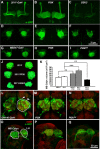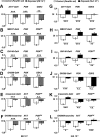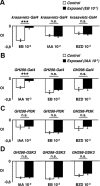Central adaptation to odorants depends on PI3K levels in local interneurons of the antennal lobe
- PMID: 22238078
- PMCID: PMC6621088
- DOI: 10.1523/JNEUROSCI.2921-11.2012
Central adaptation to odorants depends on PI3K levels in local interneurons of the antennal lobe
Abstract
We have previously shown that driving PI3K levels up or down leads to increases or reductions in the number of synapses, respectively. Using these tools to assay their behavioral effects in Drosophila melanogaster, we showed that a loss of synapses in two sets of local interneurons, GH298 and krasavietz, leads to olfaction changes toward attraction or repulsion, while the simultaneous manipulation of both sets of neurons restored normal olfactory indexes. We show here that olfactory central adaptation also requires the equilibrated changes in both sets of local interneurons. The same genetic manipulations directed to projection (GH146) or mushroom body (201Y, MB247) neurons did not affect adaptation. Also, we show that the equilibrium is a requirement for the glomerulus-specific size changes which are a morphological signature of central adaptation. Since the two sets of local neurons are mostly, although not exclusively, inhibitory (GH298) and excitatory (krasavietz), we interpret that the normal phenomena of sensory perception, measured as an olfactory index, and central adaptation rely on an inhibition/excitation ratio.
Figures




Similar articles
-
Mechanisms Underlying Population Response Dynamics in Inhibitory Interneurons of the Drosophila Antennal Lobe.J Neurosci. 2016 Apr 13;36(15):4325-38. doi: 10.1523/JNEUROSCI.3887-15.2016. J Neurosci. 2016. PMID: 27076428 Free PMC article.
-
Odor mixtures of opposing valence unveil inter-glomerular crosstalk in the Drosophila antennal lobe.Nat Commun. 2019 Mar 13;10(1):1201. doi: 10.1038/s41467-019-09069-1. Nat Commun. 2019. PMID: 30867415 Free PMC article.
-
Functional connectivity and selective odor responses of excitatory local interneurons in Drosophila antennal lobe.Neuron. 2010 Sep 23;67(6):1021-33. doi: 10.1016/j.neuron.2010.08.025. Neuron. 2010. PMID: 20869598
-
Temporally specific engagement of distinct neuronal circuits regulating olfactory habituation in Drosophila.Elife. 2018 Dec 21;7:e39569. doi: 10.7554/eLife.39569. Elife. 2018. PMID: 30576281 Free PMC article.
-
Olfactory habituation in Drosophila-odor encoding and its plasticity in the antennal lobe.Prog Brain Res. 2014;208:3-38. doi: 10.1016/B978-0-444-63350-7.00001-2. Prog Brain Res. 2014. PMID: 24767477 Review.
Cited by
-
GSK3β inhibition promotes synaptogenesis in Drosophila and mammalian neurons.PLoS One. 2015 Mar 12;10(3):e0118475. doi: 10.1371/journal.pone.0118475. eCollection 2015. PLoS One. 2015. PMID: 25764078 Free PMC article.
-
Neuron-Specific FMRP Roles in Experience-Dependent Remodeling of Olfactory Brain Innervation during an Early-Life Critical Period.J Neurosci. 2021 Feb 10;41(6):1218-1241. doi: 10.1523/JNEUROSCI.2167-20.2020. Epub 2021 Jan 5. J Neurosci. 2021. PMID: 33402421 Free PMC article.
-
Experience-dependent glial pruning of synaptic glomeruli during the critical period.Sci Rep. 2024 Apr 20;14(1):9110. doi: 10.1038/s41598-024-59942-3. Sci Rep. 2024. PMID: 38643298 Free PMC article.
-
Neuron-specific regulation of class I PI3K catalytic subunits and their dysfunction in brain disorders.Front Mol Neurosci. 2014 Feb 13;7:12. doi: 10.3389/fnmol.2014.00012. eCollection 2014. Front Mol Neurosci. 2014. PMID: 24592210 Free PMC article. Review.
-
The PI3K signaling pathway as a pharmacological target in Autism related disorders and Schizophrenia.Mol Cell Ther. 2016 Feb 11;4:2. doi: 10.1186/s40591-016-0047-9. eCollection 2016. Mol Cell Ther. 2016. PMID: 26877878 Free PMC article. Review.
References
-
- Aso Y, Grübel K, Busch S, Friedrich AB, Siwanowicz I, Tanimoto H. The mushroom body of adult Drosophila characterized by GAL4 drivers. J Neurogenet. 2009;23:156–172. - PubMed
Publication types
MeSH terms
Substances
LinkOut - more resources
Full Text Sources
Molecular Biology Databases
